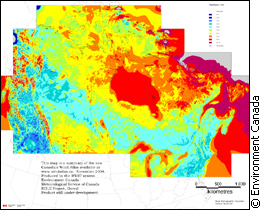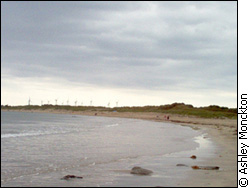| Winds
of change
By Ashley Monckton
OTTAWA
— The winds, they are a changing –
but as wind energy capacities increase throughout Canada,
one scientist says there is a possibility a change in
the winds could mean a change in the climate.
There’s no such thing
as a free lunch
"There isn’t going to be any
technology that’s perfectly clean," professor
David Keith announced to a room full of scientists,
politicians and policy-makers.
 |
| Many environmentalists
believe wind power could solve the climate change
problem. |
Keith, a Canada Research Chair in Energy
and the Environment, spoke at a breakfast on Parliament
Hill in September.
He discussed a recent study where he and
his colleagues looked at whether wind power could change
either the regional or global climate.
Keith explained that a field of wind turbines
extracts kinetic energy and alters the wind field, which
could create a change in the climate.
Proceedings of the National Academy of
Sciences published "The influence of large-scale
wind-power on global climate," last November.
Keith and his colleagues found the ratio
– between the climate changes wind energy was
intended to make, and any unintended climate changes
from wind energy – was significant enough in their
model to warrant a closer look.
 |
| An atlas of wind speed
across Canada mapping the lowest speeds (blue) to
the highest (red). |
The study used two different general circulation
models – the National Center for Atmospheric Research
model, and the Geophysical Fluid Dynamics Laboratory
model.
But Keith said it is important to remember
that coal-fired power is much worse than wind power.
The study also found that the direct climate changes
wind energy caused were beneficial enough to reduce
overall climate impacts.
"We simply have to do more work,"
he said about his results. "If you knew that [the
ratio] was, let’s say, a hundred times bigger,
which is clear the undesirable effects were much bigger
than desirable effects on climate – then that
would be it. Even though it’s a $10-billion industry
- you’d it close down."
Big picture thinker
Keith is a professor in both the department
of economics and the department of chemical and petroleum
engineering at the University of Calgary.
He is also an adjunct professor
at Carnegie Mellon University in Pittsburgh, Pennsylvania
and sits on national and international panels that deal
with climate change.
 |
| A wind farm in South-East
Ireland, near the shore of the Atlantic Ocean. |
"Everything I do is related to climate
in one way or the other. Either the technologies for
managing the problem, the public policy for managing
the problem, or the science of the problem itself,"
he said.
Joe DeCarolis, a co-author and one of
Keith’s past PhD students, said Keith’s
ability to see the ‘big picture’ is admirable.
"There are probably not enough
people in the world like David who are thinking that
far along the road," said DeCarolis.
But despite his 'big-picture' attitude,
Keith admits the response to his paper has not been
positive: "I was disappointed but not surprised
that people in the environmental community reacted so
negatively."
Whispers in the wind
Some critics have linked the study to
his position in the department of chemical and petroleum
engineering. Keith was quick to point out that the study
was not for that department and that funding came from
the National Science Foundation.
"I don’t work for the
petroleum industry. When I meet my neighbours in Calgary,
and they ask me what I do, I tell them I’m trying
to put them out of business," he said.
| 'When I meet my
neighbours in Calgary, and they ask me what I do,
I tell them I’m trying to put them out of
business.' |
Mark Jacobson, an associate professor
in civil and environmental engineering at Stanford University
in California, is also skeptical of Keith’s findings
– but not because of any perceived ties to the
industry.
"I don’t think the results
in this model prove enough," he said. "It’s
such a rough calculation."
But Keith says that just getting other
scientists, including Jacobson whom he views as an accomplished
atmospheric scientist, to even think about the study
makes it a success:
"Maybe they’ll prove that we
were totally wrong or maybe they’ll prove that
we underestimated the problem."
Keith added we should not only be aware
of our current problems, but also be cautious of any
big, new energy technology.
"I really care about the big wildernesses
in this planet, and we will wreck them if we don’t
manage the problem," he said.
|